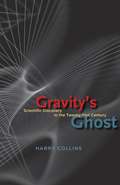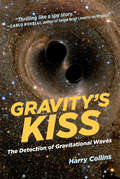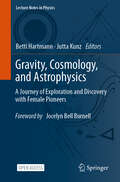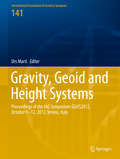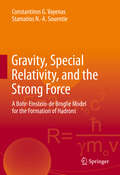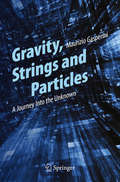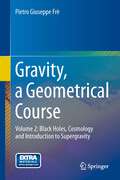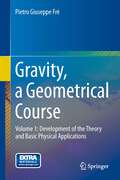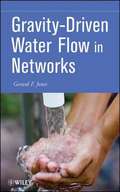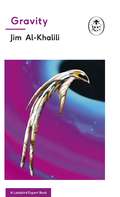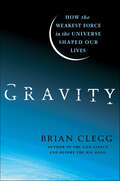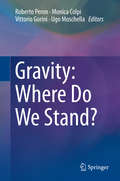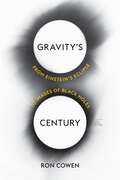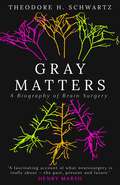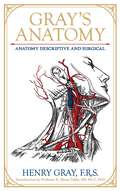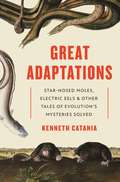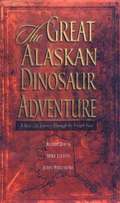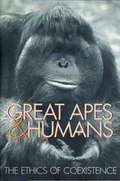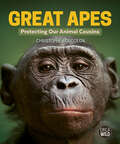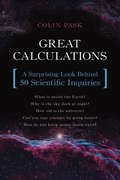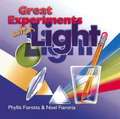- Table View
- List View
Gravity's Ghost: Scientific Discovery in the Twenty-first Century
by Harry CollinsIn theory, at least, gravitational waves do exist. We are constantly bathed in gravitational radiation, which is generated when stars explode or collide and a portion of their mass becomes energy that ripples out like a disturbance on the surface of a serene pond. But unfortunately no gravitational wave has ever been directly detected even though the search has lasted more than forty years. As the leading chronicler of the search for gravitational waves, Harry Collins has been right there with the scientists since the start. The result of his unprecedented access to the front lines of physical science is Gravity’s Ghost, a thrilling chronicle of high-stakes research and cutting-edge discovery. Here, Collins reveals that scientific discovery and nondiscovery can turn on scientific traditions and rivalries, that ideal statistical analysis rests on impossible procedures and unattainable knowledge, and that fact in one place is baseless assumption in another. He also argues that sciences like gravitational wave detection, in exemplifying how the intractable is to be handled, can offer scientific leadership a moral beacon for the twenty-first century. In the end, Gravity’s Ghost shows that discoveries are the denouements of dramatic scientific mysteries.
Gravity's Ghost: Scientific Discovery in the Twenty-first Century
by Harry CollinsA gripping look at gravitational wave research and what it says about scientific discovery and the future of the scientific community.&“This fine book pairs exploratory analysis with the pulse of a detective story. Giving a portrait of the way a community chose to test itself on the threshold of new knowledge, Collins offers the rich sociological insight that can only be won from uncommon experience, from a long-standing dialogue with the community he studies, and from a moral engagement in the future of science.&” —Richard Staley, author of Einstein&’s Generation: The Origins of the Relativity Revolution In theory, at least, gravitational waves do exist. We are constantly bathed in gravitational radiation, which is generated when stars explode or collide and a portion of their mass becomes energy that ripples out like a disturbance on the surface of a serene pond. But unfortunately no gravitational wave has ever been directly detected even though the search has lasted more than forty years. As the leading chronicler of the search for gravitational waves, Harry Collins has been right there with the scientists since the start. The result of his unprecedented access to the front lines of physical science is Gravity&’s Ghost, a thrilling chronicle of high-stakes research and cutting-edge discovery. Here, Collins reveals that scientific discovery and nondiscovery can turn on scientific traditions and rivalries, that ideal statistical analysis rests on impossible procedures and unattainable knowledge, and that fact in one place is baseless assumption in another. He also argues that sciences like gravitational wave detection, in exemplifying how the intractable is to be handled, can offer scientific leadership a moral beacon for the twenty-first century. In the end, Gravity&’s Ghost shows that discoveries are the denouements of dramatic scientific mysteries. &“A sociologist embedded (with full access!) in the LIGO Scientific Collaboration chronicles the search for gravitational waves. Though physicists, with very few exceptions, are in no doubt that gravitational waves exist, evidence for their passage through the new kilometer-length interferometers would nevertheless represent the scientific event of the twenty-first century. Harry Collins has turned the initial joined search exploiting the LIGO and Virgo instruments into a detective novel that exquisitely describes the social processes associated with discovery (and statistical analysis) in a large collaborative effort.&”—Francis Halzen, University of Wisconsin–Madison and Director of Icecube Neutrino Detector Project
Gravity's Kiss: The Detection of Gravitational Waves (The\mit Press Ser.)
by Harry CollinsA fascinating account, written in real time, of the unfolding of a scientific discovery: the first detection of gravitational waves.Scientists have been trying to confirm the existence of gravitational waves for fifty years. Then, in September 2015, came a “very interesting event” (as the cautious subject line in a physicist's email read) that proved to be the first detection of gravitational waves. In Gravity's Kiss, Harry Collins—who has been watching the science of gravitational wave detection for forty-three of those fifty years and has written three previous books about it—offers a final, fascinating account, written in real time, of the unfolding of one of the most remarkable scientific discoveries ever made. Predicted by Einstein in his theory of general relativity, gravitational waves carry energy from the collision or explosion of stars. Dying binary stars, for example, rotate faster and faster around each other until they merge, emitting a burst of gravitational waves. It is only with the development of extraordinarily sensitive, highly sophisticated detectors that physicists can now confirm Einstein's prediction. This is the story that Collins tells.Collins, a sociologist of science who has been embedded in the gravitational wave community since 1972, traces the detection, the analysis, the confirmation, and the public presentation and the reception of the discovery—from the first email to the final published paper and the response of professionals and the public. Collins shows that science today is collaborative, far-flung (with the physical location of the participants hardly mattering), and sometimes secretive, but still one of the few institutions that has integrity built into it.
Gravity, Cosmology, and Astrophysics: A Journey of Exploration and Discovery with Female Pioneers (Lecture Notes in Physics #1022)
by Betti Hartmann Jutta KunzThis book is a compilation of enlightening tutorial essays, showcasing the forefront of research by exceptional female scientists. This invaluable collection provides graduate students and researchers in the field with an engaging and pedagogical introduction to a wide range of compelling topics. Delve into the depths of theoretical and observational realms, exploring intriguing subjects including modified gravity models, quantum gravity, fields in curved space-time, particle dynamics, gravitational waves, and enigmatic black holes. Embracing both the theoretical foundations and the practical applications, this comprehensive edited volume offers an accessible and all-encompassing panorama of gravity and cosmology. Moreover, it shines a much-needed spotlight on the significant contributions made by remarkable women across the globe, fostering recognition and admiration for their indispensable role in shaping this ever-evolving field.
Gravity, Geoid and Height Systems
by Urs MartiThis volumeyincludes a selection of papers presented at the IAG international symposium 'Gravity, Geoid and Height Systems 2012' (GGHS2012), which was organized by IAG Commission 2 ?Gravity Field? with the assistance of the International Gravity Field Service (IGFS) and GGOS Theme 1 ?Unified Global Height System'. The book summarizes the latest results on gravimetry and gravity networks, global gravity field modeling and applications, future gravity field missions. It provides a detailed compilation on advances in precise local and regional high-resolution geoid modeling, the establishment and unification of vertical reference systems, contributions to gravity field and mass transport modeling as well as articles on the gravity field of planetary bodies. "
Gravity, Special Relativity, and the Strong Force
by Stamatios N.-A. Souentie Constantinos G. VayenasThis book shows that the strong interaction forces, which keep hadrons and nuclei together, are relativistic gravitational forces exerted between very small particles in the mass range of neutrinos. First, this book considers the motion of two or three charged particles under the influence of electrostatic and gravitational forces only, which shows that bound states are formed by following the same semi-classical methodology used by Bohr to describe the H atom. This approach is also coupled with Newton's gravitational law and with Einstein's special relativity. The results agree with experiments on the masses, binding energies, radii, angular moments, and magnetic moments of hadrons. The model provides the means to rationalize all the main experimental features of the strong force. Some of the implications for the unification of forces and the nature of our micro-cosmos and macro-cosmos are also discussed. The creation of mass itself, in other words, of hadrons from particles as light as neutrinos, can now be modeled in a straightforward manner.
Gravity, Strings and Particles
by Maurizio GasperiniNew fundamental forces of Nature? New forms of "dark'' energy? Signals from epochs preceding the Big Bang? Is our space-time unique? Only a joint study of the three topics examined in this book - gravity, strings and particles - may provide answers to these questions. Such a study may also provide the key to solving one of the most fascinating mysteries of modern science, namely: Besides time and the three spatial dimensions, how many other dimensions exist in our universe? The book is primarily addressed to readers who do not necessarily have a specific background in physics but are nevertheless interested in discovering the originality and the possible implications of some of the amazing ideas in modern theoretical physics. The emphasis is on conveying ideas rather than explaining formulas, focusing not on what is known but -- mainly -- on what is still unknown. Many parts of the book are devoted to fundamental theoretical models and results which are potentially highly relevant for a deeper understanding of Nature, but are still waiting to be confirmed (or disproved) by experiments. From this point of view, the material of this book may also be of interest to professional physicists, whether or not they work in the field of fundamental interactions.
Gravity, Weight and Their Absence (SpringerBriefs in Physics)
by Vladimir PletserThe book introduces readers to the concept of weightlessness and microgravity, and presents several examples of microgravity research in fluid physics, the material sciences and human physiology. Further, it explains a range of basic physical concepts (inertia, reference frames, mass and weight, accelerations, gravitation and weightiness, free fall, trajectories, and platforms for microgravity research) in simple terms. The last section addresses the physiological effects of weightlessness. The book’s simple didactic approach makes it easy to read: equations are kept to a minimum, while examples and applications are presented in the appendices. Simple sketches and photos from actual space missions illustrate the main content. This book allows readers to understand the space environment that astronauts experience on board space stations, and to more closely follow on-going and future space missions in Earth orbit and to Mars.
Gravity, a Geometrical Course
by Pietro Giuseppe Frè'Gravity, a Geometrical Course' presents general relativity (GR) in a systematic and exhaustive way, covering three aspects that are homogenized into a single texture: i) the mathematical, geometrical foundations, exposed in a self consistent contemporary formalism, ii) the main physical, astrophysical and cosmological applications, updated to the issues of contemporary research and observations, with glimpses on supergravity and superstring theory, iii) the historical development of scientific ideas underlying both the birth of general relativity and its subsequent evolution. The book is divided in two volumes. Volume Two is covers black holes, cosmology and an introduction to supergravity. The aim of this volume is two-fold. It completes the presentation of GR and it introduces the reader to theory of gravitation beyond GR, which is supergravity. Starting with a short history of the black hole concept, the book covers the Kruskal extension of the Schwarzschild metric, the causal structures of Lorentzian manifolds, Penrose diagrams and a detailed analysis of the Kerr-Newman metric. An extensive historical account of the development of modern cosmology is followed by a detailed presentation of its mathematical structure, including non-isotropic cosmologies and billiards, de Sitter space and inflationary scenarios, perturbation theory and anisotropies of the Cosmic Microwave Background. The last three chapters deal with the mathematical and conceptual foundations of supergravity in the frame of free differential algebras. Branes are presented both as classical solutions of the bulk theory and as world-volume gauge theories with particular emphasis on the geometrical interpretation of kappa-supersymmetry. The rich bestiary of special geometries underlying supergravity lagrangians is presented, followed by a chapter providing glances on the equally rich collection of special solutions of supergravity. Pietro Frè is Professor of Theoretical Physics at the University of Torino, Italy and is currently serving as Scientific Counsellor of the Italian Embassy in Moscow. His scientific passion lies in supergravity and all allied topics, since the inception of the field, in 1976. He was professor at SISSA, worked in the USA and at CERN. He has taught General Relativity for 15 years. He has previously two scientific monographs, "Supergravity and Superstrings" and "The N=2 Wonderland", He is also the author of a popular science book on cosmology and two novels, in Italian.
Gravity, a Geometrical Course: Development of the Theory and Basic Physical Applications
by Pietro Giuseppe Frè'Gravity, a Geometrical Course' presents general relativity (GR) in a systematic and exhaustive way, covering three aspects that are homogenized into a single texture: i) the mathematical, geometrical foundations, exposed in a self consistent contemporary formalism, ii) the main physical, astrophysical and cosmological applications, updated to the issues of contemporary research and observations, with glimpses on supergravity and superstring theory, iii) the historical development of scientific ideas underlying both the birth of general relativity and its subsequent evolution. The book, divided in two volumes, is a rich resource for graduate students and those who wish to gain a deep knowledge of the subject without an instructor. Volume One is dedicated to the development of the theory and basic physical applications. It guides the reader from the foundation of special relativity to Einstein field equations, illustrating some basic applications in astrophysics. A detailed account of the historical and conceptual development of the theory is combined with the presentation of its mathematical foundations. Differentiable manifolds, fibre-bundles, differential forms, and the theory of connections are covered, with a sketchy introduction to homology and cohomology. (Pseudo)-Riemannian geometry is presented both in the metric and in the vielbein approach. Physical applications include the motions in a Schwarzschild field leading to the classical tests of GR (light-ray bending and periastron advance) discussion of relativistic stellar equilibrium, white dwarfs, Chandrasekhar mass limit and polytropes. An entire chapter is devoted to tests of GR and to the indirect evidence of gravitational wave emission. The formal structure of gravitational theory is at all stages compared with that of non gravitational gauge theories, as a preparation to its modern extension, namely supergravity, discussed in the second volume. Pietro Frè is Professor of Theoretical Physics at the University of Torino, Italy and is currently serving as Scientific Counsellor of the Italian Embassy in Moscow. His scientific passion lies in supergravity and all allied topics, since the inception of the field, in 1976. He was professor at SISSA, worked in the USA and at CERN. He has taught General Relativity for 15 years. He has previously two scientific monographs, "Supergravity and Superstrings" and "The N=2 Wonderland", He is also the author of a popular science book on cosmology and two novels, in Italian.
Gravity-Driven Water Flow in Networks
by Gerard F. JonesGravity-driven water flow networks are a crucial method of delivering clean water to millions of people worldwide, and an essential agricultural tool. This book provides an all-encompassing guide to designing these water networks, combining theory and case studies. It includes design formulas for water flow in single or multiple, uniform or non-uniform diameter pipe networks; case studies on how systems are built, used, and maintained; comprehensive coverage of pipe materials, pressure ratings, and dimensions; and over 100 illustrations and tables. It is a key resource both for working engineers and engineering students and instructors.
Gravity: A Ladybird Expert Book
by Jim Al-KhaliliHow does gravity work? Learn from the experts in the ALL-NEW LADYBIRD EXPERT SERIESDiscover the vast and momentus effects of this profound force on the world around us, written by celebrated physicist and broadcaster Jim Al-Khalili.Inside you will learn:- What is Gravity?- How does it work?- And why are there extreme gravitational environments?Above all, discover how gravity controls the shape of space and the passage of time itself, influencing the history and destiny of the entire Universe.IT'S SO MUCH MORE THAN 'WHAT GOES UP MUST COME DOWN.'Gravity is a fascinating and authoritative introduction to a phenomenon as familiar to us as breathing.Learn about other topics in the Ladybird Experts series including The Big Bang, Quantum Physics, Climate Change and Evolution.
Gravity: How the Weakest Force in the Universe Shaped Our Lives
by Brian CleggA history of gravity, and a study of its importance and relevance to our lives, as well as its influence on other areas of science.Physicists will tell you that four forces control the universe. Of these, gravity may be the most obvious, but it is also the most mysterious. Newton managed to predict the force of gravity but couldn’t explain how it worked at a distance. Einstein picked up on the simple premise that gravity and acceleration are interchangeable to devise his mind-bending general relativity, showing how matter warps space and time. Not only did this explain how gravity worked—and how apparently simple gravitation has four separate components—but it predicted everything from black holes to gravity’s effect on time. Whether it’s the reality of anti-gravity or the unexpected discovery that a ball and a laser beam drop at the same rate, gravity is the force that fascinates.
Gravity: Where Do We Stand?
by Ugo Moschella Vittorio Gorini Monica Colpi Roberto PeronThis book presents an overview of the current understanding of gravitation, with a focus on the current efforts to test its theory, especially general relativity. It shows how the quest for a deeper theory, which would possibly incorporate gravity in the quantum realm, is more than ever an open field. The majority of the contributions deals with the manifold facets of "experimental gravitation", but the book goes beyond this and covers a broad range of subjects from the foundations of gravitational theories to astrophysics and cosmology. The book is divided into three parts. The first part deals with foundations and Solar System tests. An introductory pedagogical chapter reviews first Newtonian gravitational theory, special relativity, the equivalence principle and the basics of general relativity. Then it focuses on approximation methods, mainly the post-Newtonian formalism and the relaxed Einstein equations, with a discussion on how they are used in treating experimental tests and in the problem of generation and detection of gravitational waves. Following this is a set of chapters describing the most recent experiments, techniques and observations on the testing of gravity theories in the laboratory, around the Earth and in the Solar System. The second part is dedicated to astrophysical topics deeply linked with the study of gravitation, namely binary pulsars and the perspective of direct detection of gravitational waves. These cases are paradigmatic in that the gravitational signals act at the same time as messengers helping us to understand the properties of important and wide classes of astrophysical objects. The third part explores the many open issues in current knowledge of gravitation machinery, especially related to astrophysical and cosmological problems and the way possible solutions to them impact the quest for a quantum theory of gravitation and unified theory. Included is a selection of the many possible paths, giving a hint to the subtleties one is called upon. Whenever possible, a close link to observational constraints and possible experimental tests is provided. In selecting the topics of the various contributions, particular care has been devoted to ensure their fit in a coherent representation of our understanding of gravitational phenomena. The book is aimed at graduate level students and will form a valuable reference for those working in the field.
Gravity’s Century: From Einstein’s Eclipse to Images of Black Holes
by Ron CowenRon Cowen offers a sweeping account of the century of experimentation that has consistently confirmed Einstein’s general theory of relativity. He shows how we got from Eddington’s pivotal observations of the 1919 eclipse to the Event Horizon Telescope, aimed at starlight wrapping around the black hole at our galaxy’s center.
Gray Matters: A Biography of Brain Surgery
by Theodore Schwartz&‘A fascinating and wide-ranging account of what neurosurgery is really about – the past, present and future.&’ Henry Marsh, author of Do No Harm Since its inception in the early twentieth century, brain surgery has maintained an air of mystery. As the saying &‘it&’s not exactly brain surgery&’ suggests, the specialty has become synonymous with a level of complexity and meticulousness rivalled only by, well, rocket science. Warm, rigorous and deeply insightful, neurosurgeon Theodore Schwartz reveals what it&’s really like to get inside someone&’s head – where every second can mean the difference between life or death. Drawing from Schwartz&’s experience in one of New York&’s busiest hospitals, Gray Matters explores the short but storied history of brain surgery. From the dark days of the lobotomy to the latest research into the long-term effects of contact sports on athletes&’ cerebral health, Schwartz unfolds the fascinating story of how we came to understand this extraordinary, three-pound organ, which not only keeps us alive, but makes us who we are.
Gray's Anatomy: Anatomy Descriptive and Surgical (Leather-bound Classics)
by Dr. Henry Gray FRSThis version of the original 1858 first edition of Gray&’s Anatomy is ideal for students and those with a keen interest in medicine.In 1858, Dr. Henry Gray published the first edition of what has become known as &“the doctor&’s Bible," with assistance from his colleague at St. George&’s Hospital in London, the anatomist and medical illustrator Henry Vandyke Carter. Their efforts led to the most famous reference book on human anatomy, which continues to be updated and revised today. This edition of Gray&’s Anatomy contains the original text and black-and-white illustrations from the first edition, providing valuable historical insights into the study and discussion of human anatomy. Also included are several key illustrations presented in full color. Dr. R. Shane Tubbs, Neurosurgery Professor and Anatomical Research Director at Tulane University Clinical Neuroscience Research Center, provides a scholarly introduction with details about Henry Gray&’s life and career, and examines the impact that the text has had on generations of medical practitioners, students, and the general public.
Great Adaptations: Star-Nosed Moles, Electric Eels, and Other Tales of Evolution’s Mysteries Solved
by Kenneth Catania"The irresistible enthusiasm of Great Adaptations couldn’t come at a better time."—David P. Barash, Wall Street Journal"Be very amazed."—Carl Safina, author of Beyond Words and Becoming WildHow one scientist unlocked the secrets behind some of nature’s most astounding animalsFrom star-nosed moles that have super-sensing snouts to electric eels that paralyze their prey, animals possess unique and extraordinary abilities. In Great Adaptations, Kenneth Catania presents an entertaining and engaging look at some of nature’s most remarkable creatures. Telling the story of his biological detective work, Catania sheds light on the mysteries behind the behaviors of tentacled snakes, tiny shrews, zombie-making wasps, and more. He shows not only how studying these animals can provide deep insights into how life evolved, but also how scientific discovery can be filled with adventure and fun.Beginning with the star-nosed mole, Catania reveals what the creature’s nasal star is actually for, and what this tells us about how brains work. He explores how the deceptive hunting strategy of tentacled snakes leads prey straight to their mouths, how eels use electricity to control other animals, and why emerald jewel wasps make zombies out of cockroaches. He also solves the enigma of worm grunting—a traditional technique in which earthworms are enticed out of the ground—by teaming up with professional worm grunters. Catania demonstrates the merits of approaching science with an open mind, considers the role played by citizen scientists, and illustrates that most animals have incredible, hidden abilities that defy our imagination.Examining some strange and spectacular creatures, Great Adaptations offers a wondrous journey into nature’s grand designs.
Great Alaskan Dinosaur Adventure
by John Whitmore Buddy Davis Mike ListonFIVE SOULS, huddled against the aching cold of the Alaskan wilderness. On a hunt for truth amid the shrieks of wild animals, the clouds overhead race swiftly by. Adventures from left to right: Mike Liston, Buddy Davis, Dan Specht, George Detwiler, and John Whitmore. LOCKED in a remote, frozen wasteland where man has rarely been lie remains of creatures so mysterious, science can scarcely believe the truth. A team of scientists and researchers endured incredible hardships to reach a site many would rather avoid - the Alaskan wilderness - and in the process, uncovered unfossilized dinosaur bones. The implications are enormous, for how can dinosaurs be 65 million years old if their bones are still unfozzilized? Join the team and thrill at the photographs and tales of danger, as The Great Alaskan Dinosaur Adventuredrops a bombshell on the scientific community. See once again why true science honors the pages of the Bible.
Great Apes and Humans
by Michael Hutchins Terry L. Maple Bryan Norton Tara S. Stoinski Benjamin B. BeckThe great apes -- gorillas, chimpanzees, bonobos, and orangutans -- are known to be our closest living relatives. Chimpanzees in particular share 98 percent of our DNA, and scientists widely agree that they exhibit intellectual abilities long thought to be unique to humans, such as self-awareness and the ability to interpret the moods and identify the needs of others. The close relation of apes to humans raises important ethical questions. Are they better protected in the wild or in zoos? Should they be used in biomedical research? Should they be afforded the same legal protections as humans?Great Apes and Humans is the first book to present a spectrum of viewpoints on human responsibilities toward great apes. A variety of field biologists, academic scientists, zoo professionals, psychologists, sociologists, ethicists, and legal scholars consider apes in both the wild and captivity. They present sobering statistics on the declining numbers of wild apes, specifically discussing the decimation of great ape populations due to wild game consumption. They explore the role of apes in the educational missions of zoos as well as the need for sanctuaries for wild ape orphans and former research subjects. After examining the social division between apes and humans from historical, evolutionary, and cognitive perspectives, they conclude by reviewing the current moral and legal status of great apes as well as how apes' cognitive skills inform these issues.Although this provocative book contains many different opinions, the uniting concern of the contributors is the safety and well-being of great apes. Only by continuing the dialogue so clearly presented here can we hope to ensure their future.
Great Apes: Protecting Our Animal Cousins (Orca Wild #15)
by Christopher GudgeonLet's meet the great ape family! Get to know our charismatic chimpanzee cousins, the peaceful bonobos, three types of high-flying orangutans and those gentle giants of the jungle, the gorillas. Discover where and how they live, their biology, what they eat and what they share in common with humans—beyond their opposable thumbs. These giant mammals are our closest relatives in the animal world, known for their intelligence, complex social structures and communication skills. But great apes everywhere are in trouble. Their habitat is being destroyed by deforestation and the effects of climate change. Their population is dropping, and fast. In Great Apes, find out what conservationists, scientists and young people all over the world are doing to protect them. The epub edition of this title is fully accessible.
Great Calculations
by Colin PaskScience is based not only on observation and experiment, but on theory as well. As Einstein said, "Theory tells us what to measure." And theories are often crystallized into succinct calculations, like those made using Einstein's famous E = mc2. This book looks at fifty such great calculations, exploring how and why they were developed and assessing their impact on the history of science.As the author shows, many significant scientific calculations are quite simple and fairly easy to understand, even for readers will little math background. But their implications can be surprising and profound.For example, what links a famous comet and the cost of an annuity? Why do scientists claim there is "dark matter" in the universe if it can't be observed? How does carbon-based life on Earth depend on a quirk of nuclear physics? The answer to each question is an illuminating calculation. This accessible, engaging book will help you understand these breakthroughs and how they changed our view of life and the world.From the Trade Paperback edition.
Great Experiments With Light
by Phyllis Fiarotta Noel FiarottaSee the light--and how it reflects, bounces, travels, and more, with super experiments like these: Create shadow pictures of animals "Talk" with someone using sunbursts! And you'll be able to get started right away because many of the materials you need can be found around the house. Make a light-ray fan, a magnifying bottle, a string highway, spooky ghosts... All it involves is a little light--but it will give you a lot of excitement! Provides step-by-step instructions for experiments that explore the qualities of light, including refraction, reflection, absorption, and the travel of light.
Great Experiments in Physics: Firsthand Accounts from Galileo to Einstein
by Morris H. ShamosFrom Galileo's famous experiments in accelerated motion to Einstein's revolutionary theory of relativity, the experiments recorded here trace the evolution of modern physics from its beginnings to the mid-twentieth century. Brought together for the first time in one volume are important source readings on 25 epochal discoveries that changed man's understanding of the physical world. The accounts, written by the physicists who made them, include:Isaac Newton: The Laws of MotionHenry Cavendish: The Law of GravitationAugustin Fresnel: The Diffraction of LightHans Christian Oersted: ElecromagnetismHeinrich Hertz: ElectromagneticJames Chadwick: The NeutronNiels Bohr: The Hydrogen Atom, and 17 more.Morris H. Shamos, Professor Emeritus of Physics at New York University, has selected and edited the first published accounts of these important experiments and has also added numerous marginal notes that amplify and clarify the original documents. Moreover, the first 19 experiments can be readily re-created by students in a first-year physics course, making the book ideal for classroom and laboratory work as well as individual reference and study.Finally, Dr. Shamos has provided revealing biographical sketches of the scientists and illuminating references to the political and cultural milieu in which the discoveries are made. The result is a superbly readable presentation -- accessible to lay readers -- of the crucial theoretical and empirical breakthroughs that altered the course of modern science.
